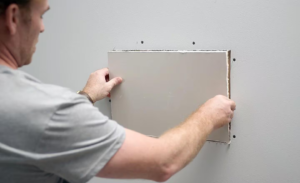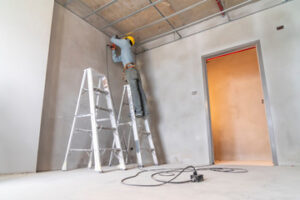Drywall Contractors Phoenix helps homeowners with various renovation projects. They can repair cracks, sagging ceilings, and water damage and install new sheets of drywall for home additions or renovations.
When searching for a good drywall contractor, consider their experience and reputation. Make sure they have a portfolio and are ready to provide references. Check for licensing and insurance requirements in your area.

Drywall contractors install the walls and ceilings of building construction projects. Their main day-to-day tasks involve measuring, cutting, and fitting these panels into the framework of structures and ensuring that they are smooth and finished to meet building standards and aesthetic requirements. They may also apply joint compound to seams between drywall sheets, and sand and spackle walls and surfaces to create a seamless appearance.
These professionals can work on both residential and commercial construction projects. They know the specific requirements and regulations for each, including fire safety and soundproofing. They have the expertise to ensure that drywall is installed correctly and efficiently, saving time and money for their clients.
A qualified drywall contractor will use top-quality tools, materials, and products, so that they can complete the job in a timely manner. They will also be able to handle any problems that might occur during the project. This way, the end result will be a high-quality finished product that adds value to your home or business.
Before you hire a drywall contractor for your construction project, it’s important to check whether they are licensed and insured. This will ensure that they have the proper training and qualifications for the job. You should also ask for references and check their work history. It’s best to avoid hiring unlicensed and unskilled drywall contractors, as they can do damage to your property.
You should also ask a potential drywall contractor for a quote before you hire them. This will help you determine if they can fit the job within your budget. It’s also a good idea to keep records throughout the project, including the hours worked and progress each day. This will help you avoid any surprises later on.
Local drywall contractors are your best bet when it comes to fixing damaged walls in your home. They have several years of experience and specialized tools that allow them to work much faster than an amateur. They can also save you a lot of money by helping you cut down on repair costs.
Drywall contractors can also perform demo and build the framing around drywall but many do not as it throws off their schedules. They also may not have the qualifications to fix plumbing or electrical (that would be a C-33 painter or a C-5 carpenter’s license) and that can tack on extra costs and headaches.
Repair
Drywall is the foundation upon which your home improvement projects rest, so it’s important to make sure it’s installed correctly. When it’s not, you can suffer from a host of issues including unsightly holes, structural damage and poor indoor air quality. Fortunately, drywall contractors offer a variety of repair services to ensure your walls look great and stand the test of time.
Dry wall repairs are an essential part of any homeowner’s maintenance routine, and they can help prevent costly damage down the road. Whether your drywall is damaged from an accident or simply ageing, a drywall professional can take care of it quickly and efficiently. These professionals are skilled at repairing a wide range of problems, including repairing large holes, drywall sagging, and drywall cracking.
They can also fix ceilings that are sagging or showing signs of moisture damage. In many cases, this can be a simple fix by pulling up the old ceiling and replacing it with new drywall. They can also install drywall insulation to improve your home’s energy efficiency.
Local drywall contractors prioritize personalized service, and they know how to work with the regulations and codes specific to your region. This allows them to provide an efficient service with minimal disruption. Their close proximity allows them to respond quickly to any questions or concerns that you may have, ensuring they can solve the problem as soon as possible.
In addition to standard drywall installation and repair, these contractors can also perform specialized jobs for commercial clients. These include seismic retrofitting, lead-lined drywall for medical facilities and fire rated drywall for stairways and emergency exits. They can also work within the constraints of historic preservation standards to restore drywall in older homes.
Drywall contractors can help homeowners renovate their homes and add value to them. They can also do a variety of other tasks around the house, such as painting and installing drop ceilings. They can even add crown molding and baseboards to rooms to give them an elegant touch. However, it’s important to find a contractor who specializes in drywall to avoid any problems down the line.
Refinishing
Drywall contractors can complete a variety of services that can add value to your home and improve its appearance. These include painting, texturing, sanding, and completing specialty projects like accent walls or drop ceilings. They can also assist with renovations by repairing or replacing existing drywall. If you’re looking for a high-quality finish that will last for years, you’ll want to hire a professional drywall contractor with the skills and experience to perform your work correctly.
A professional drywall contractor will inspect the area to determine if you need any repairs or restorations. If you’re building a new structure, they’ll collaborate with other tradespeople to ensure the drywall meets the required specifications for the project. This may include installing electrical wiring or plumbing pipes, working around existing fixtures, or matching the texture and finish of adjacent walls.
If you’re planning a remodeling project, your drywall contractor can help with design concepts and layouts. They’ll use their expertise to advise you on material and product selection, and they’ll provide a detailed cost estimate for the entire job. The final price will depend on a number of factors, including the size of the room, the type of drywall used, and any special finishes.
Once the drywall is hung, your contractor will apply joint compound, or mud, to the seams and joints. They’ll then sand and smooth the mud, creating a flawless surface for wall treatments such as paint or wallpaper. The sanding process can take up to several days, so you’ll need to plan accordingly. If you’re concerned about a delay in finishing your project, consider scheduling a walkthrough with your drywall contractor at the beginning and end of the day to make sure they’re on track.
A drywall contractor can handle a wide variety of projects, from creating custom home theaters and soundproofing to restoring fire damage in historic buildings. Some drywall professionals hold multiple licenses to offer a full range of construction services. These may include a C-5 framing and rough carpentry license, a C-6 cabinet, millwork, and finish carpentry license, or a C-10 electrical contracting license.
Maintenance
Drywall is an integral part of the construction process for both new homes and renovations. It helps to seal the house against outside air, insulates from sound and temperature differences, and provides a smooth surface for painting and other finishes. However, over time, drywall can become damaged due to accidents or natural wear and tear, and it is crucial to address any problems quickly.
While many homeowners can rely on DIY techniques, a professional drywall contractor is best equipped to handle all types of repairs and maintenance. These specialists will assess the issue and provide recommendations for the most effective solution, using their experience to ensure that the repair is done correctly and prevents future issues.
Local Drywall Contractors
In addition to their expert skills, local drywall contractors prioritize personalized service and quick response times. They also have extensive knowledge of local regulations, ensuring compliance and helping you avoid costly mistakes.
Some drywall contractors may specialize in areas like custom home theaters or soundproofing, which require specialized installation techniques. Others may choose to focus on energy-efficient or green building projects, which are becoming increasingly popular. Still others may choose to focus on structural framing and rough carpentry, a career that requires different skill sets but can help them diversify their portfolio of work and find new opportunities.
Depending on the type of work they perform, drywall contractors may also hold other licenses or certifications to enhance their abilities and offer more services to clients. For example, if they specialize in interior painting, they can obtain a C-33 Painting and Decorating Contractor License to become a one-stop shop for their clients.
The main reason why many people call a drywall contractor is to fix or repair damage caused by accidents, wear and tear, or water leaks. These experts can take care of any issues promptly and effectively, ensuring that the walls remain in good condition and allowing the homeowner to enjoy all the benefits of their property. Moreover, they are well-versed in the safety protocols and proper practices for working with gypsum wallboard, and can work safely alongside other professionals on construction sites.

